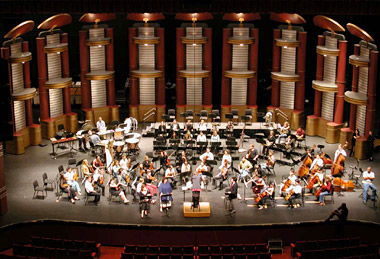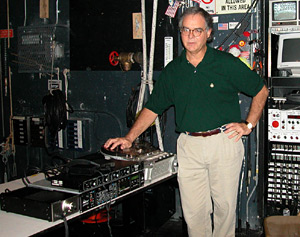![[SoundStage!]](../sslogo3.gif) Surrounded! Surrounded!Back Issue Article |
February 2002 A Visit from Peter McGrath of Wilson Audio Specialties -- Part Two Peter McGrath's recording of the Florida Philharmonic's Mahler’s Symphony No.2 embodies the successful music surround experience as well as any piece we listened to over the course of our weekend. In my notes, I wrote terms like "emotion," "dynamic envelope," "impact," and "sense of space." Let's zero-in on the word "space." What does space mean in terms of live music? Music is sometimes described as "a succession of tones in time." But any specific performance of music takes place not just in time but also in space -- a specific space. Listening to a string quartet in a living room is a totally different experience from listening to that same quartet in a concert hall. A listener's emotional response to music is certainly related to the setting -- the environment itself -- but more importantly, emotional response is closely tied to the environment’s relationship to the music occurring within it. Imagine a great lion crossing the Serengeti Plain. Then crop just the lion out of the picture and place it on a blank page. The lion is unchanged, but the overall picture has changed dramatically. That is what space adds to the equation. It’s where the music belongs. When Peter McGrath switched from the multichannel Mahler to the two-channel version, my sense of the music's space disappeared. And my sense of being enveloped by the music disappeared. I went from being a participant in the event to an observer. My sense of being within the music was precisely what made it sound real. Score one for multichannel!
The space in which the Florida Philharmonic Orchestra was performing was reproduced properly because the sound is generated in much the same configuration as it was originally produced. Peter summed up this point accurately when he stated they were playing, "into the space rather than into your face." The music was not cropped away from its environment. Rear-hall ambience should always come from the rear, but this information should be presented in correct proportion with the direct sound coming from the front. With everything coming from the right direction, the sounds combine in a unique manner at the listening position. Peter ruminated, "It’s not what’s in front and behind, but what 's in between." Think about this concept for a second. Where are you sitting? In a space between the front and rear of the hall. What you are actually hearing in a live performance is the mixture of direct and reflected sound as it combines at your seat. Stand up and move toward the front of the room, and it sounds as if you are walking closer to the performers. When you turn around and walk toward the rear, it should sound as though you are walking away from them. But you should not be assaulted by a wave of reflected sound coming from your rear speakers any more than you would be from the reflected sound from an auditorium's rear wall. This subtle balance was reproduced properly in Peter McGrath’s recordings. Not just ambience The improvement goes beyond ambience, though. Let's look at one of the big bass-drum whacks delivered by the orchestra in Mahler’s Symphony No. 6 (the system’s sound was so precise, Peter could identify, for the first time, which of the Florida Philharmonic’s two percussionists was on stage that night!). The concept of "impact" as it applies to live music -- not to mention how reviewers have used the term in the context of two-channel recordings -- is interesting. We’ve all been socked in the gut by a drum whack, but is that the end of that sound as it decays? Not really. It rolls through the hall from front to rear in a wave. You sense it approach and surround you as it pressurizes the room before trailing off slowly. If you listen to live music, you know exactly what I’m talking about. You can reproduce that precisely with four speakers when the recording is perfectly synced in time, level, and tonality. The drum whack reproduced by the front channels rolls forward and precisely at the right moment is met by the rear channels, which in turn pick up the sound to give the listener the sense that the drum's sound is filling the hall before dying away. This was an effect I clearly heard on the multichannel recording that was not present when we switched off the surrounds. The fundamental and the harmonic must be reproduced precisely. This combination of feeling the lower bass and hearing the upper harmonics simultaneously is crucial in convincing the listener that the listening room is much larger than it actually is. This sensation of real space is dependent upon information actually being reproduced behind the listener and in precise conjunction (and proportion) with the front-channel information. Other factors I would be remiss if I did not admit that some of the magic I heard over the course of my weekend listening with Peter McGrath had to do with the contribution of the magnificent Wilson-anchored system. It is important to note the subtle low-level detail of the decay, which could only be reproduced thanks to the speakers' fundamental neutrality. Tonality uncompromised by dynamic compression, cabinet resonance, or various distortions is essential in reproducing the texture of the music.
Overtime Throughout the weekend, as the music continued, it became increasingly clear to me that the way I listened to music would be changed forever. I only wish I had an unlimited supply of multichannel master tapes, properly recorded, and a system with the appropriate playback gear to listen to them. I can now understand why Peter has been so adamant about letting folks hear his work. The reason for his persistence is that he knows it sounds dangerously close to the real thing. It’s purely and simply better -- by a wide margin. I’m not going to attempt an explanation as to how this would be modified for studio recordings because that is simply irrelevant to this discussion. The point is: Peter McGrath’s recordings are of live music, and the technology he uses allows him to capture a very close approximation of the event on tape. And it can be played back in the home! Applause So, I hear you asking, why tell us about music we can't buy that needs to be listened to on systems we can't afford? Because, now that Peter McGrath has shown me what's possible, I want more. And since most of us have systems that can be adapted to play back multichannel recordings, it seems silly to confine our music listening to a two-channel technology created 50 years ago, when properly recorded surround sound can be so much more natural-sounding. The problem is, most people -- most record companies, most engineers, and, inevitably, most consumers -- currently think of surround as a gimmick. As long as we consumers let them get away with this, that's all it will be. But if we demand more -- if we refuse to accept kettledrums to the rear of us and insist instead on using the extra channels to create a lifelike ambience -- we have ahead of us a new era in musical reproduction, an era in which music, an art form that exists not merely in time but also in space, finally unites those two dimensions in our homes. I've heard it done. I know we can achieve it. And I think it's worth making some noise about -- don't you? ...Jeff Fritz
|
|
![[SoundStage!]](../sslogo3.gif) All Contents All ContentsCopyright © 2002 SoundStage! All Rights Reserved |
 Stereo loudspeakers have the
ability to paint a fairly accurate picture, if the information is present on the
recording. Adding two more channels in the rear allows for some rear-stage imaging as well
as left- and right-side imaging, too (to a lesser degree). On a properly recorded
multichannel live performance such as Peter’s Verdi Requiem, the images float
within a three-dimensional space that extends throughout the room. This is something that
two channels simply cannot do. Listening to the multichannel recording contrasted with the
two front channels alone proved this to me conclusively.
Stereo loudspeakers have the
ability to paint a fairly accurate picture, if the information is present on the
recording. Adding two more channels in the rear allows for some rear-stage imaging as well
as left- and right-side imaging, too (to a lesser degree). On a properly recorded
multichannel live performance such as Peter’s Verdi Requiem, the images float
within a three-dimensional space that extends throughout the room. This is something that
two channels simply cannot do. Listening to the multichannel recording contrasted with the
two front channels alone proved this to me conclusively. There’s more: the dynamic
range of Peter McGrath’s recordings. From a low 40dB to peaks over 105dB, you’re
hearing a range in excess of 65dB. This incredible lack of compression leads you to truly
hear the proper decay of an instrument as it trails off into the noise floor of the hall.
How can we expect to reproduce live music with the compression that is typically used in
commercial recordings? The dynamic restrictions truncate the music, and hence the
emotional content. This has little to do with multichannel sound per se, but has
everything to do with evaluating it accurately here. Peter stated, "If you can’t
make an exceptional two-channel recording, you stand little chance of making an
exceptional multichannel recording."
There’s more: the dynamic
range of Peter McGrath’s recordings. From a low 40dB to peaks over 105dB, you’re
hearing a range in excess of 65dB. This incredible lack of compression leads you to truly
hear the proper decay of an instrument as it trails off into the noise floor of the hall.
How can we expect to reproduce live music with the compression that is typically used in
commercial recordings? The dynamic restrictions truncate the music, and hence the
emotional content. This has little to do with multichannel sound per se, but has
everything to do with evaluating it accurately here. Peter stated, "If you can’t
make an exceptional two-channel recording, you stand little chance of making an
exceptional multichannel recording."